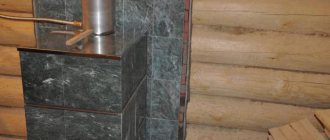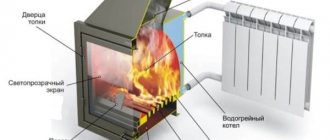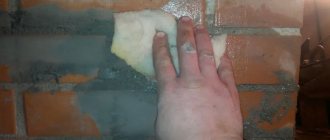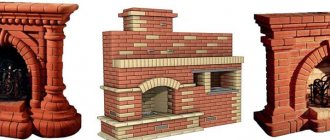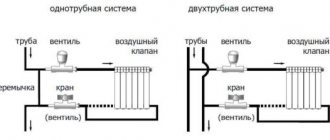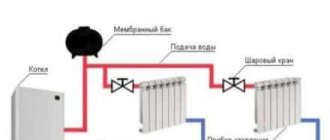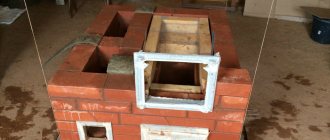Homemade stove made of cast iron pipe
One of the alternatives to branded cast iron sauna stoves is a homemade stove made from a cast iron pipe. The availability of the material allows us to talk about the possibility of creating such a device. For this, pipes with a diameter of at least 50 cm are usually used. The wall thickness of such pipes should be 10-12 mm. For construction, you will need a section 80-100 cm long. Since cast iron is difficult to weld at home, the blower can be made of brick or the section can be installed on a steel platform. The grate is welded from reinforcement with a thickness of 14-16 mm. The top cover is made of steel sheet 8-10 mm thick. The only difficult element of the design is the door, but even here you can get out of the situation by attaching the door hinges to the bolts.
The best manufacturers
There are many metal stoves on sale that run on different types of fuel:
- wood;
- electrical;
- gas;
- combined.
Each owner chooses, according to his capabilities, the layout of the premises.
Let's list the most popular manufacturers.
Vesuvius
The company is represented on the market with a wide range of sauna stoves with cast iron fireboxes. In terms of power, the units are capable of heating rooms with an area of 6–30 cubic meters. m.
Attention is paid to the appearance of the stove. Closed versions with a solid door and forged elements are available for sale.
For those who like to watch a live flame, models with a door made of heat-resistant glass have been developed.
Troika
Domestic manufacturing company. Production is located in Tver.
The designs are excellent for use in Russian baths.
Among the features of the ovens:
- Material – low alloy steel. Thickness – from 10 mm.
- Logs up to 80 cm long can be heated inside, which is very rare for stove fireboxes.
- The grates and doors are made of cast iron. No risk of deformation.
- Hot steam flows are regulated by special windows in the housing.
- In some models, the volume of stone laying is up to 250 kg.
- In a stove with a water tank, the container is removable, which simplifies its maintenance.
- Quick heating of a room of any size.
The stoves have good power. If desired, they can be lined with bricks on the outside. Such designs turn out to be very beautiful.
Teplodar
On sale are:
- boilers with a steam generator built inside;
- mesh ovens;
- convectors;
- stoves with a water tank.
There are products with a closed combustion door and with a panoramic one made of heat-resistant glass.
In addition, design development and custom manufacturing are possible. Official representative offices provide installation and maintenance services for equipment.
Termofor
Another name is TMF. Production facilities are located in Novosibirsk. The main specialization is the production of wood-burning stoves for baths. But in recent years, a line of gas and electric devices has been added.
Based on material, products are divided into 2 groups:
- Made from stainless steel. The model name contains the word INOX.
- Made from structural steel. Budget equipment. Marked with CARBON marking.
All units are produced in 2 versions:
- Top class. Made of thickened metal, with a design thought out to the smallest detail.
- Budget. The quality of the metal remains unchanged. The design is as simple as possible.
Breneran
The German company appeared on the Russian market in 1993. Until 2005, the product was called Bulleryan, then it changed to Breneran.
The stoves do not burn out because the grates are made of cast iron. No maintenance required. The entire product line is covered by a manufacturer's warranty of 2.5 years.
Pros and cons of different designs
Depending on the circumstances, individual advantages may outweigh the disadvantages. It is clear that if the tank is located on the stove or attached to the side, then three unpleasant things follow from this:
- Constant heating of water will lead to the formation of steam, but it will not be the steam heated over 100 degrees, which is called light - it is obtained only from overheated stones. And the usual heavy steam will pour out of the container, which makes it difficult to stay in the steam room.
- Using heated water for washing is problematic if the steam room is not combined with a steam room. You will have to carry hot water to the washroom and wash the way your ancestors washed).
- In tanks built on the side of the stove, heating occurs the worst, because the walls of the stove do not heat up as much as the top or chimney. Plus, over time, the wall of the tank itself will lose thermal conductivity due to scale, and the wall of the furnace will lose its thermal conductivity due to scale. Therefore, the water does not warm up well, remains cold at the bottom, and must be stirred manually.
However, such structures also have advantages - they are easy to fill with water precisely because the container is not located high. But this is if there is no cold water supply either. Otherwise, the plus is leveled out.
By the way! The larger the contact area between the container with water and the oven, the faster the heating. But this is not always worth striving for - why do you need clouds of heavy steam in an unheated bathhouse?
Of course, you still have the opportunity to set up a shower from any tank. And, although stove makers do not recommend using a pump, the forced circulation of liquid in the system will calmly take water from either the manual or the attached tank. The main thing is not to forget to add more.
We ourselves consider the optimal system to be one in which the tank is mounted on the chimney. Whether it will be a large tank or a heat exchanger depends on how you are more accustomed or more comfortable to wash. Well, or whether there is a pump in the system or not.
Photo: samovar-type heat exchanger
However, the optimal system also has its drawbacks. In particular, traders admit that the connection between the tank and the pipe at the inlet below can suffer greatly from overheating, for example, in a situation where water is poured after the stove has been lit. Then the seam splits and needs to be welded. Another drawback is that the pipe burns out when the furnace heats up too much.
Pay attention to the size of the filler hole. For some tanks it is large, it even has a hinged lid, while for others it is small, round
Still, you will have to fill tens of liters, and also wash the inside of the tank from time to time!
On a note! The stove should not be heated to the limit of its capabilities. This shortens the service life of the metal, which inevitably oxidizes and turns into scale, and then it crumbles and holes remain. The bottom piece of the chimney will also burn out if you heat it like this. If you don't want this, insert a piece of black structural steel pipe of the required diameter inside. It will take away some of the heat and add strength to the structure.
Useful video
This video explains in more detail about strengthening the chimney with pipe cutting:
You can learn more about the disadvantages of a hinged and chimney-mounted tank from the following videos:
https://www.youtube.com/watch?v=S5TRvRjgmLs
Features and operating experience (from owner reviews)
According to the information posted on the official website of the manufacturer, the advantages of Zhara stoves are:
- Long service life of units up to 20 years. This is achieved due to the cylindrical shape of the combustion chamber and the reinforced arch of the firebox. According to reviews from the owners, the Zhara stove has been used without any complaints for many years. Opinions often positively note the quality of welds, which affects the durability of the structure.
- The heat transfer of the stove is 2 times greater compared to analogues of other stainless steel sauna stoves. This was achieved through the use of durable carbon steel ST 20, which has the best thermal conductivity, in the manufacture of the firebox.
- The spiral chimney eliminates the direct flow of hot gases; their movement is directed along the heater like a snake. Thus, the heating of the stones is enhanced and fuel savings are ensured. According to the manufacturer, the steam room can be heated to 100 °C in an hour or even less, provided that the room is properly insulated. Experience in operating Heat stoves shows that the steam room actually heats up quickly: in the summer in 30 minutes, and in the winter in 2-3 hours.
- The dismountable design of the damper assembly allows for convenient cleaning of the chimney.
- Various ways to attach a water tank - remote, on the back wall, on a pipe. The tanks are easy to install and detach, which allows you to take into account the characteristics of specific rooms. According to owner reviews, the design of the tank allows you to add water without disconnecting it from the stove. It is also noted that the water in the tank remains warm the next day.
- The combination of a simple and original design and high heat transfer provides the best combination of price and quality, which is invariably noted by the owners.
Air flow pattern
Along with the above advantages, the operating experience of Zhara stoves shows some shortcomings, namely:
- Fragile coloring. Additionally, when ordering a protective coating for the stove and pipe assembly, some customers were faced with the fact that the paint simply peeled off.
- Not the best appearance is also indicated in reviews, but some stove owners lined it with brick and the problem disappeared.
- There is no online payment service on the manufacturer’s website; you can purchase goods only by paying a bank account.
Of course, Zhara sauna stoves may not have an elegant appearance, but as operating experience and reviews show, the products of this brand are of excellent quality. There are some disadvantages, but they are not critical and are easily covered by the low price.
How to choose
You should choose a wood-burning stove based on the preferred option for organizing the combustion process:
- if you will heat it from a steam room, then it is better to give preference to a model with an enlarged heater without an external combustion tunnel;
- in the case of laying firewood from an adjacent room - stoves with a protrusion-tunnel, determining its size by the type of bricklaying - 125, 200 and 250 mm (for laying ½ brick, “in a block” or “in a brick”).
Diagram of the “Heat” stove with an external firebox - To heat a bathhouse from the street, you need to choose units with a combustion chamber. Diagram of the “Heat” stove with an elongated combustion chamber for loading fuel from the street
Table 3: Technical characteristics of Zhara stoves equipped with a combustion chamber for heating from the street or dressing room
| Options | Malyutka 500 (500U) | Baby 400E | Standard 500 |
| Steam room volume, m3 | 4-16 | 4-14 | 14-26 |
| Width, mm | 450 | 450 | 540 |
| Depth, mm | 750 | 600 | 810 |
| Height, mm | 710 | 600 | 750 |
| Firewood length, mm | 720 | 570 | 720 |
| Firebox roof thickness, mm | 6 (9) | 4 | 8 |
| Weight, kg | 78 (96) | 46 | 112 |
| Weight of stones, kg | 90 | 40 | 100 |
| Chimney diameter, mm | 114 | 114 | 114 |
| Service life, years | 10 (20) | 5 | 20 |
| Warranty, years | 1 (3) | 1 | 3 |
| Firebox size WxDxH, mm | 320x250x360 | 320x200x360 | 340x250 (350)x400 |
| Water tank, liters | 20-100 | 20-100 | 50-100 |
When choosing, it is also important to take into account that the thicker the wall of the combustion chamber, the longer the service life of the stove and the longer the factory warranty period. For example, for bath stoves with a combustion chamber wall thickness of 4–6 mm, the factory warranty period is 1 year, 8 mm — 3 years, 10–12 mm — 5 years.
Homemade designs of different types
There are several common modifications of sauna stoves with a water tank. They are designed for rooms of different sizes and different operating conditions. We invite you to consider the options and choose the most suitable one.
Model "Skif"
Option #1: with heat exchanger and remote tank
Installing an external tank is a guarantee that the steam room will not be filled with unnecessary raw steam, because... the water does not boil ahead of time. The design is an improved potbelly stove, which has a special register for heating water in the firebox, and a heater above the firebox.
The most convenient option for arranging a heater is an open metal mesh or pocket. A closed pocket is not suitable, because... when steam comes out of it, the temperature is too high. This increases the risks for people in the steam room: you can get serious burns.
A sauna stove with an external tank can be purchased ready-made or made with your own hands. For its manufacture, sheet steel with a thickness of 4-5 mm is suitable. For the register and tank, it is better to take stainless steel. The tank must be mounted at a height of at least 0.5 m from the register, and connected to the register using pipes or hoses.
Scheme of a heater with a water tank
Option #2: heater from an iron barrel
To make a sauna stove with a water tank and a heater, you can use a used iron barrel. The main thing is that it is not leaky or rusty. To get a metal cylinder, cut off the upper and lower parts, then install a grate.
Part of the structure is filled with bricks. They are installed on the edge. 2/3 of the space will be occupied by the heater. All that remains is to install the chimney and bring it to the roof. This design has a serious drawback. If it is not covered with a lid, gases enter the steam room. If you cover it, you will have to remove the lid every time you need to add steam.
Scheme of a barrel furnace
Option #3: sheet metal construction
You can make your own sauna stove with a tank made of sheet metal 5-10 mm thick. This will require a detailed drawing. Theoretically, you can develop it yourself, but if you don’t have the necessary skills, it’s better to use a ready-made one. One of the successful options is suggested below:
Ready drawing for making a stove
The metal is cut in accordance with the drawing. To avoid mistakes, all elements are first cut out from sheets of cardboard. These blanks are laid out on metal and the elements are outlined along them, after which they are cut with a grinder. The finished parts are welded.
The stove is installed in the same way as other models. For better heating of the steam room, you can place a brick screen at a distance of 15-20 cm from the structure.
Homemade iron heater
Installation Features
There are some specifics for installing Heat stoves (gas and wood):
Installation diagram of Zhara stoves
- If the floor where the stove is installed is made of flammable materials, then protection should be installed with a metal sheet over a 10-mm layer of asbestos cardboard so that the edges of the metal protrude 250 mm around the perimeter. The distance from the floor to the bottom of the stove should be 100 mm; it is recommended to use a foundation laid in a quarter of a brick.
- To protect the hot metal body from the intense heat, a protective screen made of brick or other fire-resistant material is installed around the stove. The brick screen is made in ½ or ¼ brick at a distance of 40–50 mm from the furnace body; in its lower part, air passages are arranged in increments of 250 mm. To lay a protective convection screen made of brick, it is better to use oven bricks, and prepare the mortar from sand and red clay.
- The partition between adjacent rooms into which the heating unit is installed, in the immediate vicinity of the stove on the left, right and top must be made of fireproof materials of at least 500 mm. Read more in the article “How to install a metal stove for a bath.”
- The chimney must be at least five meters high. Plan a straight option for its placement with a minimum number of knees.
Warning! The manufacturer categorically does not recommend making the connections between the stove and the chimney and the water tank non-separable. This is necessary to prevent fires and ease dismantling.
Metal sauna stove with water tank
They can be made from different materials. Cast iron stoves for wood-fired saunas equipped with a water tank are not recommended for use, since the metal cannot withstand sudden temperature changes and is destroyed.
A do-it-yourself sauna stove made of metal does not require a massive foundation. To protect the floor surface, you need to lay a metal sheet. It will prevent possible fire due to fallen coal. An asbestos cement sheet is added on top of it.
A detailed design of an iron furnace with a water heat exchanger is being developed. All structural elements must be taken into account: heater, valve, firebox, ash door. Additional fittings may be required, which are made of steel for a good connection using a welding machine.
A cast iron (metal) sauna stove is usually equipped with an iron pipe. In this case, the valve is located at the top of the furnace, since it is convenient rather than reaching up to the pipe.
What to make it from? You can use any iron sheets or devices (cylinders, car rims, barrels), but it is better to use special 20K steel (boilers are made from it). Steel 20X13 can also be used to create heat exchangers or fireboxes for sauna stoves. The second option is more expensive. The thickness of the sheets is taken to be more than 5 mm.
Options from manufacturers can be equipped with a built-in tank or have remote tanks. The main material is high-quality cast iron, which lasts a long time and does not fade. Heating water in a bathhouse using a metal heater is almost no different: the brick version takes longer to heat up, but retains heat for a long time, the steel version warms up quickly and cools down quickly.
The features of the device must be reflected in the completed project. Welding work is carried out in accordance with the drawings and recommendations.
Design features
By easily changing the size of the combustion chamber, the power of the furnace can be adjusted.
The remaining important compartments are no different from the brick version. At the very bottom there is a firebox, which has a blower hole. Above is a heater for placing cobblestones. Then a valve is installed that allows you to regulate the heating power of the water tank.
The heater is made to the maximum size that fits on a homemade device. To increase maximum heat transfer, a special casing is added to the design. This is a unique alternative to the smoke circulation of stone stoves.
The advantage of a metal heater is the ability to attach a water tank to a sauna pipe. It is easy to build if you have welding skills.
In most cases, a do-it-yourself sauna tank is made of various types, depending on the selected equipment configuration (mounted, internal, etc.). The material is high-quality metal sheets or stainless steel.
What to drown with
A heat sauna stove requires the correct choice of fuel, since this determines how long it will work, what the heat transfer and efficiency will be. It is recommended to burn with dry logs up to 100 mm thick and 50 to 100 mm long.
Before placing firewood in the firebox, you need to light the chamber. The following types of materials are suitable for this:
- Shavings
- crumpled paper
- Split logs
- Birch bark
The kindling material should fill the chamber only halfway so that the water in the tank boils gradually. Before lighting a fire, you need to check that there is water in the water tank, filling the container two-thirds full.
For kindling, do not use flammable mixtures such as acetone, gasoline, or solvent.
Kinds
Depending on the location of the tank relative to the furnace, they are divided into the following subtypes:
With mounting tank
Wood-burning stove Zhara-Malyutka 700PU. Dobrostal Photos
The most ancient method of heating: the oven was made in such a way that there was free space on its upper surface or even a special recess was made for a container of water.
The water warmed up well, located in a container directly above the firebox. And the heater was next door to it.
Today you have at your disposal many models of stoves that allow, if necessary, to install an upper tank, which, by the way, can most often be purchased from the manufacturer at the same time as the stove.
As an example, we can name the “Zhara-Malyutka” 700PU oven. It is equipped with a 50-liter water tank (there is a 30-liter option).
With mounted or attached
Sauna stove with water tank - a hinged type of tank
The location in this case is the same, but the fastening may be different. Such a tank receives heat from the side wall of the furnace. At the same time, manufacturers let the owner decide on which side of the stove the water tank will be located - this is essential for baths with a small steam room space.
The side tank can either be hung on special hooks, or simply placed on a pad - heat transfer will take place in any case, but not very much.
An example is Ermak stoves, which can be equipped with mounted tanks.
With built-in
It is difficult to classify such tanks as a separate type, because in practice it is still the same container located on the side, only without the possibility of removing it. Some manufacturers continue to make similar designs. As an example, let’s take the Siberia stove, which is made by NMK.
Bath stove with water tank Kastor - built-in tank
With external
Regardless of which room the hot water tank will be placed in, the design will be the same. If all previous tanks were in one way or another in direct contact with the furnace, then this type is located at a considerable distance, so heating is carried out using a heat exchanger.
You can read about the types of heat exchangers on our website in the article dedicated to them.
Most often, remote tanks are used to not only supply the washroom with hot water, but also to heat the room in which the tank is located. By the way, there are several options:
- Some people prefer to take the tank to the washing room;
- others place it in the dressing room;
- still others are left in the steam room;
- the fourth are taken to the attic.
If the first three differ little from each other, then the last option has functional significance. You probably know that for gravitational pressure you need to raise the water tank as high as possible. If you just hang the tank on the wall, you are unlikely to be able to wash yourself in the shower. But if you lift the tank into the attic, then washing in the shower, which is usual for a city dweller, becomes quite possible.
ADVICE! The heat loss from an uninsulated tank in the attic will be too great. Therefore, such a tank is usually lined with one or another heat insulator, maybe even with foil.
There are many examples of remote tanks. Almost every manufacturer has them along with heat exchangers.
Wood-burning sauna stoves with a tank are a remote type of tank.
With a tank on the chimney
Sauna stove with a tank on the chimney.
We have already mentioned the advantages of such tanks above. Now it's time to clarify their design. The fact is that you always have a choice: attach to the chimney a full-fledged tank of tens of liters or a small one of 5-10 liters, which will serve as a heat exchanger, that is, transfer heat further to a large tank.
Both options increase the efficiency of the furnace, but there will still be some heat loss when transferred to a remote reservoir.
Additional equipment
Wood-burning sauna stoves Zhara are additionally equipped with water tanks with a volume of 20 to 100 liters with various installation options:
- on a pipe (samovar type) - the tank is installed on the smoke duct or on the stove, which makes it easy to remove;
- mounted on the back or side wall of the oven. In the first option, the tank is more tightly adjacent to the furnace body, heating the water faster;
“Zhara” stoves are equipped at the customer’s request with different types of water tanks - remote with a heat exchanger - the tank is installed at a distance from the unit.
What types of water tanks are there, what are their advantages and disadvantages, read the article “Sauna stoves with a water tank. Which ones are better?!”
In addition, a chimney, a heat exchanger, protective screens, a closed heater, a glass door made of heat-resistant glass, a protective coating made of heat-resistant paint and various accessories for the bath are additionally purchased. The grate (cast iron in some models) is supplied free of charge.
Advantages and disadvantages of Zhara stoves
We can talk about the benefits of Zhara sauna stoves for a very long time. In order not to bore you with lengthy stories, we suggest that you familiarize yourself with the key advantages of the units in question. For greater ease of perception, the information is presented in table form.
Table. Advantages of Zhara sauna stoves
| Advantage | Description |
| Life time | On average, these objectively budget-friendly sauna stoves can easily last up to 15-20 years (the most inexpensive ones last up to 8-10). Such durability is ensured, first of all, by the high quality of the starting materials (the manufacturer states that the pipes used in the construction of the furnace are similar to those used for the construction of oil pipelines), as well as by the features of the combustion chamber - here it has a cylindrical shape. Additionally, the service life of the furnace is positively influenced by the presence of a reinforced firebox arch and high quality welds. In accordance with reviews from real users, Zhara sauna stoves have been serving for many years without any kind of complaints. |
| Heat dissipation | Heat stoves are characterized by very high heat transfer rates, which is achieved through the use of St20 carbon steel for the manufacture of the firebox - this is a durable material with excellent thermal conductivity. |
| Chimney | The manufacturer recommends using branded spiral chimneys in combination with Zhara stoves. The design features of the smoke exhaust system exclude a direct flow of heated gases - here they move in a “snake” along the heater. Thanks to this, the stones heat up much more intensely, which allows for effective fuel savings. This feature also has a beneficial effect on the speed of warming up the steam room: in summer it takes about 40-60 minutes, in cold periods - up to 2-3 hours (often less). |
| Gate unit | In proprietary designs it is collapsible. This structural feature makes cleaning the smoke exhaust system as convenient as possible. |
| Multiple water tank mounting options available | The container can be mounted on the wall, on the stove body or on the smoke exhaust pipe. Installation and dismantling of the tank is carried out in the shortest possible time and without significant effort. The containers are designed in such a way that water can be added to them without the need to disconnect the unit from the stove. At the same time, branded tanks retain heat for as long as possible. According to reviews from the owners, in the spring-summer period of the year the water remains warm even the next day after heating the bathhouse. |
| Affordable price | Despite the excellent quality, heat transfer and durability, Zhara sauna stoves are sold at an affordable price, much more attractive compared to the cost of similar units from other manufacturers. |
Heat stove diagram
Along with numerous advantages, Zhara sauna stoves have a number of disadvantages and shortcomings.
Firstly, the color is fragile. According to user reviews, over time the base enamel coating will simply peel off. To solve the problem, you have to order additional protective coating.
Secondly, not the most attractive appearance. The disadvantage, although subjective, is mentioned quite often. To solve this problem, many owners line the stove with bricks.
Brick case to protect the bath from extreme heat
Brick screen for the Zhara stove with a hanging tank
Thus, even despite the few and in fact not the most significant drawbacks, Zhara stoves can safely be considered an excellent option for installation in a bathhouse. The existing shortcomings are not critical and are fully compensated by high quality, affordable cost and long service life.
Sauna stoves “Heat” with a tank on a pipe photo
Prices for Zhara products
Compact option - suitable for small steam rooms
The range of iron stoves is wide and allows you to choose a unit for a room from 4 to 40 m3. The company is so confident in the quality of its products that it provides a warranty period of 1 to 3 years for each product (depending on the thickness of the furnace compartment roof), but the “life” of the stove declared by the manufacturer is 20-25 years.
There are several reviews posted online. The authors say that they have been using Zhary stoves for several years (some for two years, others for five) and so far they are happy with everything.
Here's one review:
We have a Heat stove in our bathhouse, we bought it last year in August (post date 06/30/2013). We started using it constantly, only this year. We spent a long time choosing and settled on a Zhara stove. My husband is happy, the stove heats up the steam room and sink quickly enough. The tank is removable, but we do not remove it; we remove the lid from above and fill it with water. The next morning after heating the bathhouse, the water in the tank was warm and at a comfortable temperature; we were surprised.
The high quality of the welds and the fairly high efficiency of the furnaces are also noted: the next morning the water in the hanging tank is still warm, and a room with a volume of 12 cubic meters warms up in the winter in an hour and a half, depending on the outside temperature.
Another review:
At my dad’s dacha, I have two Heat stoves, one for heating, the other for a bathhouse, 8 mm thick, exactly like in the picture. I can say the oven is “not a piece of cake,” but it was clear that it was made very well. There were four of us unloading it - a serious “infection”...) My dad is a retired welder, he says that the welding seams are factory-made. We fenced it with brickwork, only stones and a stainless steel tank are visible from above, in principle it looks good. Briefly, what can I say, when we flooded it for the first time, we prepared knee-deep wood, it took 1/3 of what was prepared to kindle it, and after 30 minutes it was 100 degrees in the steam room. I think we’ve been using it for eight years now, no complaints. I think that the stove will last at least another fifteen years. Another thing, the neighbors in the bathhouse had a teplodar or thermobor stove, well, the one with a heat-resistant firebox. After two years, the firebox burned out or cracked. They wanted to sue, they spat... Based on our recommendation, they ordered “Heat”, now they’re happy to f... s...)
One of the variants of the “Heat” stoves
In a fairly large assortment, you can find/assemble the stove you need (or order its production, again for additional money).
Operating principle of the furnace
Almost all wood-burning heat sources operate according to this principle: first, firewood is placed in the firebox, which heats the equipment, and its walls produce heat transfer. As a result, the room is quickly heated, but at the same time the temperature does not last long, which is why it is necessary to constantly add firewood.
Principle of operation
Long-burning heating devices differ from traditional stoves in the possibility of long-term heat transfer without the need to frequently add firewood. The intervals between tosses are about 20 hours. Such furnaces operate on the principle, the peculiarity of which is the reverse direction of the combustion process, that is, from top to bottom.
Construction of a long-burning furnace
Product cost
Purchasing equipment always involves some costs. But today, the search for sauna stoves with the optimal combination of price and quality is no longer relevant, since devices under the Zhara brand have appeared.
Their average price is about 10,000 rubles, although there are more expensive as well as cheaper models. So anyone can choose the option that suits them.
Production of stoves for baths Heat
A wide range of stoves for baths is provided. This developing manufacturing enterprise, located in the city of Tolyatti, is characterized by the use of modern technologies, a high culture of work organization and a clear system of product quality control. Each model undergoes mandatory preliminary tests before release, which guarantees its trouble-free operation for many years. In addition to mass production, the company produces models for individual orders, taking into account the wishes of the buyer.
The company aims to manufacture products that perform their intended functions to the maximum extent possible without unnecessary cost-increasing additions. Therefore, inexpensive, but high-quality Zhara sauna stoves are gratefully called folk stoves.
Taking into account the possibility of using different types of fuel, the Zhara company offers two types of sauna stoves: wood and gas
